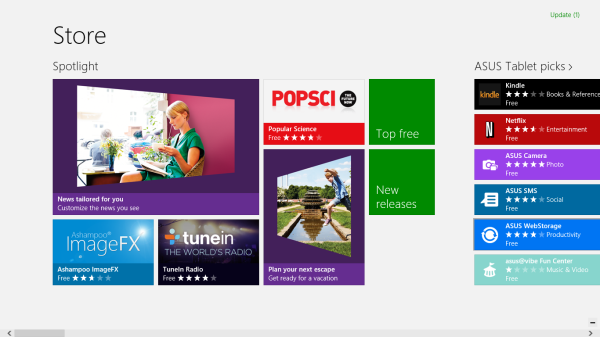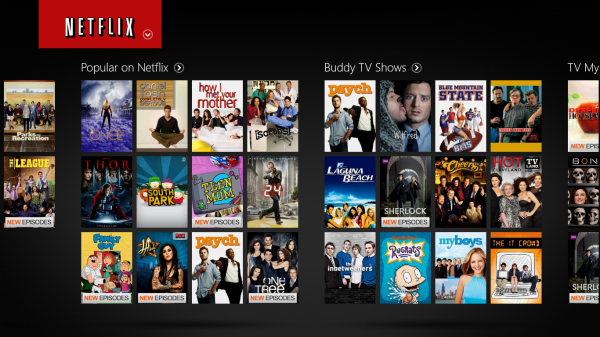The Windows RT Review
by Vivek Gowri & Anand Lal Shimpi on October 25, 2012 12:00 PM EST- Posted in
- Windows RT
- Operating Systems
- Microsoft
- Mobile
- Windows 8
- Tablets
Windows Store and the 3rd Party App Situation
So the third party app situation, out of the gate, is the biggest issue I can see with Windows RT. Obviously, with ARM processors, typical x86 legacy programs are out, so you’re forced to rely exclusively on the Windows Store for third-party applications. Within the Windows Store itself, almost all of the applications are compatible with both x86 and ARM architectures - Microsoft claims around 90% off the apps on the Windows Store at launch are compatible with both Windows 8 and Windows RT, and it appears that a lot of developers will be releasing applications on the Store for both platforms simultaneously.
The problem is that currently, there aren’t that many apps, and of them, not many are very good. Obviously, we’re still a couple of days from launch and I’m expecting a significant uptick in the number of quality apps on the 26th particularly, but also over the coming weeks and months. As the new versions of Windows gain market share, the Store will grow and mature.
Let’s talk about the Store itself. It’s a bit of a mixed bag. Yes, the Metro visual style looks great here, as it does almost everywhere else. Metro just lends itself well to anything involving lots of rectangular pictures (or app icons, in this case). Unfortunately, the Store is a bit poorly organized, and it’s difficult to find really relevant applications. The “Top Free” list needs a “Top Paid” companion, and there absolutely needs to be a “Sort by most reviews” option. Those two things would make it significantly easier to find the high-volume, headlining applications in any given category. I also really, really want the option to see all applications made by a specific developer (like, say, Microsoft.) The inability to do so is a pretty significant oversight from where I stand. These are all pretty simple fixes, just a few extra organizational options that would go a long way to making the store easier to navigate.
For right now, the best apps I can recommend on the Store are staples like Kindle, Netflix, Evernote, and Wikipedia, along with news and shopping apps from USA Today, NBC News, eBay, Newegg, and Popular Science. Other notable applications include IM+ and a number of internet radio apps like iHeartRadio, TuneIn Radio, and Slacker. In addition to those and a number of applications and games from Microsoft and Microsoft Studios - Xbox SmartGlass, Fresh Paint (a new paint application), OneNote MX (the Metro redesign of OneNote, still a preview), the Modern UI version of Remote Desktop, Reckless Racing, Hydro Thunder, etc - there’s not much out there, except maybe Fruit Ninja.
There’s still a lot of 3rd party stand-ins for applications that will get first party support, like a BBC News application actually developed by BBC and things like that. These independent apps can sometimes be good, but are almost always outdone by the first party ones. It’s just a matter of design and quality. I know that ESPN is slowly but surely bringing out their suite of applications - their cricket and football (soccer) apps were both released recently, which indicates that Scorecenter and their other applications for online radio and live video will all hit the store in the near future, but they’re just one developer. I just don’t know how much time it will take for a majority of those applications to be released. Skype isn’t currently available in the store, but will be on the 26th, which makes me wonder how many new applications will hit Windows Store in time to coincide with the official launch date of Windows 8. I want to revisit this a week from now, or even just two days from now, to see where things stand.
I’ve seen a lot of early reviews of Windows RT-based tablets decry the app situation, but I’m assuming the growth will occur significantly more quickly than it has for, say, Windows Phone, for one simple reason: this is still Windows. A very different kind of Windows, yes, but it’s not like people will stop buying Windows computers. Windows Phone has had issues gaining marketshare over the last two years, but starting tomorrow, 85% (or more) of computers being sold worldwide will be running either Windows 8 or Windows RT. There are too many people out there with new Windows systems for developers to somehow just stop releasing Windows applications.
It's important to remember that devs aren’t creating apps for Windows RT specifically, they’re creating new applications for the new Windows UI, which just happens to cover two very different hardware platforms. Nobody worries about the state of Windows 8 applications because all of the legacy desktop apps will still work, but the Windows Store will develop and mature at the same pace regardless of whether you’re looking at Windows 8 or Windows RT. Everyone worrying about Windows RT tablets and third party apps should have the same concerns about touch-centric apps for Windows 8 tablets.
But regardless, we’re still missing some huge applications at this point: Facebook, Twitter (though Rowi makes for a good stand-in), Dropbox, Pandora, Yelp, any kind of Google service, anything from Adobe, and generally useful but not necessarily headlining financial and bank-specific apps. Check back with us in a few days, because I don’t think the Windows Store will stay as sparsely populated as it is currently, but until that changes, there will be questions.












233 Comments
View All Comments
taltamir - Friday, October 26, 2012 - link
Good observation.Being impartial I have to say I am applying the argument fairly to both sides.
I held that Windows v Mac has windows as the clear winner due to sheer amount of software.
And the iOS is clearly superior to Window (singular) Metro for the same reason.
PeteH - Thursday, October 25, 2012 - link
No one's going to install 10s of thousands of apps, but if you want an app with a specific feature that doesn't have wide appeal you might not find it unless the ecosystem you're using has 10s of thousands of apps to choose from.StormyParis - Thursday, October 25, 2012 - link
You're confusing depth and breadth. 10,000 fart apps does not mean there *has* to be 1 medical clinic management app, 100,000 10 .. etc etc. I would assume the vertical market devs that most probably already have Windows apps, maybe even XP for Tablet apps, will be rather quick to port them not only to Win8, but to Metro. It will certainly not take a month though, probably more like a year or two, and MS need to prove quickly they can sell their stuff.PeteH - Thursday, October 25, 2012 - link
No, I'm saying that the fewer apps a platform has, the less likely it is that the platform will have an app with a smaller target audience. It's the classic long tail argument, when there are only a small number of apps they will focus on the fatter head.Also, I'm not speaking of any platform specifically, just as a general rule.
Stuka87 - Thursday, October 25, 2012 - link
If you are making reference to the iOS App store, to say most of them are "fart and flashlight" apps is incredibly naive. Sure there are apps that are very basic and/or useless/pointless. But to say they are the majority is laughable.And does any one person install them all? Of course not. But not everybody has the same wants or needs. So it takes a large pool of apps to make everybody happy.
It will be quite some time before the MS store gets enough apps to have the same coverage. I too think a month is being overly ambitious.
StormyParis - Thursday, October 25, 2012 - link
There was that bit last moth about 75% of apps not having been downloaded even once ?PeteH - Friday, October 26, 2012 - link
I hadn't seen that story, so I looked it up. It was an estimate by an outside agency (not official numbers), and was 60%, but that's still eye opening.Although thinking about it, is it really surprising? The more apps available the more crappy apps (or crapps, if you will) available. I would assume such a relationship is common across platforms, at least once some threshold is reached.
What would be really interesting would be a breakdown of those apps. How many were free vs. paid? Of the paid apps, what is the distribution across price?
extra_medium - Saturday, October 27, 2012 - link
Laughable? Are you serious? Of course the majority of apps are pointless / crap. Do you really think over 350k of the 700k plus apps available to iOS users are high quality?Also not surprised at the 60% - 75% of apps never being used estimates. With the sheer volume available I'm actually surprised that number isn't higher. The average user isn't going to dig to find undiscovered gems. They are going to look at top sellers, listen to Leo laporte, and see what their friends use.
I do agree with the argument though that a huge marketplace is advantageous. Even if the vast majority is pointless, there are more of those gems out there.
Dekker - Thursday, October 25, 2012 - link
I think that the pricing of the apps is going to be crucial. If the Windows RT apps are all $10-20 (like the Mac AppStore) then that kills impulse buying and they are not going to be nearly as popular as the IOS apps (typically $1-3). Windows RT will then suffer as a consequence.As mentioned by others this is a platform war and starting a virtuous circle in software development is very tough at this stage of the Tablet market. That is particularly so if developers are targeting the corporate market, which is only a fraction of the consumer market for Tablets.
a5cent - Thursday, October 25, 2012 - link
A good piece of software is certainly worth $10 - $20! People go to the cinema for that price too, right?A software title that is targeted at impulse buyers, isn't likely to be even worth $1. We don't need 100's of thousands of apps, we need a couple thousand really really good ones and if they cost a bit more that is absolutely fine by me. I'll take quality over quantity anytime.